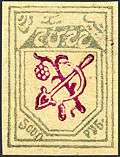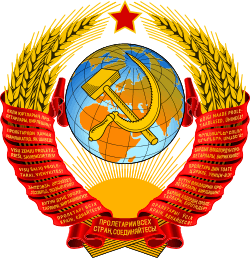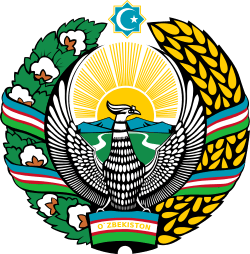Khorezm People's Soviet Republic
| Khorezm People's Soviet Republic | ||||||||||||||
| Xorazm Xalq Sho'ro Jumhuriyati (Uzbek) Хорезмская Народная Советская Республика (Russian) | ||||||||||||||
| ||||||||||||||
| ||||||||||||||
| Motto Butun dunyo proletarlari, birlashingiz! "Proletarians of all countries, unite!" | ||||||||||||||
.svg.png) The Khorezm People's Soviet Republic in 1922. | ||||||||||||||
| Capital | Khiva | |||||||||||||
| Languages | Uzbek | |||||||||||||
| Religion | ||||||||||||||
| Government | Socialist republic | |||||||||||||
| Chairman | ||||||||||||||
| • | 1920–1921 (first) | Hoji Pahlavon Niyoz Yusuf | ||||||||||||
| • | 1924–1925 (last) | Temurkhoja Yaminoghli | ||||||||||||
| Historical era | Interwar period | |||||||||||||
| • | Abdication of Sayid Abdullah | 2 February 1920 | ||||||||||||
| • | Republic established | 26 April 1920 | ||||||||||||
| • | National delimitation of Soviet Central Asia | 17 February 1925 | ||||||||||||
| ||||||||||||||
| Today part of | | |||||||||||||
The Khorezm People's Soviet Republic (Uzbek: Xorazm Xalq Sho'ro Jumhuriyati; Russian: Хорезмская Народная Советская Республика, Khorezmskaya Narodnaya Sovetskaya Respublika) was created as the successor to the Khanate of Khiva in February 1920, when the khan abdicated in response to popular pressure, and officially declared by the First Khorezm Kurultay (Assembly) on 26 April 1920. On 20 October 1923, it was transformed into the Khorezm Socialist Soviet Republic (Russian: Хорезмская ССР, Khorezmskaya SSR).[1]
.jpg)
On 27 October 1924 the Khorezm SSR was divided between Uzbek and Turkmen SSRs and the Karakalpak Autonomous Oblast as part of the delimitation of Central Asia according to nationalities.[2]
Politics
Chairman of the Revolutionary Committee
- Hoji Pahlavon Niyoz Yusuf (2 February 1920 – March 1920)
Chairman of the Provisional Government
- Jumaniyoz Sulton Muradoghli (March 1920 – 30 April 1920)
Chairmen of the Presidium of the Assembly of People's Representatives
- Hoji Pahlavon Niyoz Yusuf (30 April 1920 – 6 March 1921)
- Qoch Qoroghli (6 March 1921 – 15 May 1921) (Chairmen of Provisional Revolutionary Committee)
- Khudoybergan Divanoghli (15 May 1921 – 23 May 1921)
Chairmen of the Presidium of the Central Executive Committee

- Mulla Nozir (23 May 1921 – June 1921)
- Allabergan (June 1921 – September 1921)
- Ata Maqsum Madrahimoghli (September 1921 – 27 November 1921)
- Jangibay Murodoghli (27 November 1921 – 23 June 1922)
- Abdulla Abdurahmon Khojaoghli (23 June 1922 – 20 October 1923)
- K. Safaroghli (20 October 1923 – 1924)
- Sultonkari Jumaniyoz (1924)
- Temurkhoja Yaminoghli (1924 – 17 February 1925)
Geography
The Khorezm People's National Republic bordered on the Turkestan Autonomous Soviet Socialist Republic to the north and to the south, and on the Bukharan People's Soviet Republic to the east. Its western border was a rough continuation of the western coast of Aral Sea, bordering on what was then the Kirghiz ASSR (today's western Kazakhstan). It had an area of 62,200 km2 (24,000 sq mi) and a population of more than 600,000 people, mainly Uzbeks (62.5%), Turkmens (28.6%), Kazakhs (3.5%), and Karakalpaks (3.0%). Its capital was Khiva.[1]
See also
References
- 1 2 Khorezm People's Soviet Republic: Big Soviet Encyclopedia on-line edition. (Russian)
- ↑ Погорельский И.В. История Хивинской революции и Хорезмской народной советской республики 1917-1924 гг., Ленинград: Изд-во ЛГУ, 1984
External links
- History of the Khorezm People's Soviet Republic: The first Khorezm Kurultay
- History of the Khorezm People's Soviet Republic: Djunaid Khan's revolt




